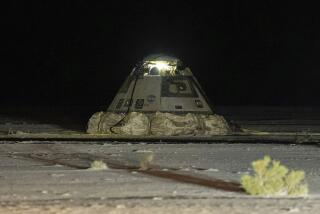Columbia’s Crew Lived After Radio Calls Ended
- Share via
The crew of the Columbia lived for at least one minute after their last communication with NASA ground controllers in Houston, a potentially important finding that could affect future efforts to improve the survivability of space shuttle accidents, investigators said Tuesday.
The details of the crew’s final moments in space have been among the most closely guarded aspects of the probe, but in recent days the Columbia Accident Investigation Board has received a briefing on new findings that suggest the crew survived past their final transmissions sent by the shuttle, the investigators said.
Ground controllers had known for several minutes that something was abnormal on the shuttle, having seen unusual spikes in some temperature sensors and other temperature sensors go dead. NASA lost all communication with the shuttle at 8 a.m. CST, only 16 minutes before it was to touch down at Cape Canaveral, Fla.
By then, the shuttle, flying at 12,500 mph, was raining tons of debris over East Texas. A great deal of information has since been reconstructed from an onboard data recorder that ground search teams recovered on March 19.
The data recorder continued to operate and store critical information after signals from the Columbia had either stopped or became garbled. An analysis of the data now suggests that the crew did not perish when communications went dead but perhaps lived for a minute or longer, according to investigators. That information was first reported in today’s editions of the New York Times.
Laura Brown, a spokeswoman for the investigating board, said the board would have no comment on the entire subject of how or when the crew perished. Brown noted that from the very beginning of the accident, board Chairman Harold Gehman Jr. has said he would not discuss that subject.
Ejection System
If the crew survived longer than earlier believed, it could lend more credibility to the idea that an ejection system could provide some hope of surviving another accident.
“One thing we are certainly concerned with is crew survivability,” said one source close to the investigation. “But I would not say we have concluded that it’s a possibility to have a crew survivability system, based on what we have heard.”
The board has said it would not make a formal recommendation that NASA install a crew ejection system that could save the astronauts during launches and reentries, but rather would leave that decision up to Congress and the space agency.
The influential astronaut office at the Johnson Space Center is examining whether it will make its own independent recommendation that the shuttle fleet be retrofitted with such an escape system. Its would be in the billions of dollars and represent the most difficult technical and financial issue for the future of the shuttle program.
If Columbia’s astronauts did survive longer into the accident than earlier believed, it would closely parallel what happened in the 1986 Challenger disaster, when it was later disclosed that astronauts had survived the initial explosion during the shuttle’s launch and did not die until their crew compartment hit the Atlantic Ocean.
In the aftermath of that accident, the Rogers Commission, which investigated it, recommended that NASA develop a crew survival system. NASA did provide parachutes and a pole for astronauts to slide down, but the system would only be useful during a controlled reentry below 30,000 feet altitude. Many critics regarded it as next to useless.
A detailed timeline of the Columbia accident, constructed by the board, shows that the final breakup occurred at exactly 8 a.m. EST. But the data recorder shows that at that moment, many of the critical mechanical systems on the Columbia were still operating.
Normal Operation
The ship’s auxiliary power units were normal and the fuel cells were still generating electrical power. It could be surmised that the crew compartment was among the last parts of the shuttle to have broken up and that the astronauts were well aware of the unfolding accident.
Transmission from the Columbia stopped about 32 seconds before the breakup and then resumed for the final two seconds. Just before the 30-second blackout, shuttle commander Rick Husband radioed to Houston, “Roger uh,” responding to a transmission that temperature sensors for the landing gear were reading above normal.
Early in the investigation, it was disclosed that either Husband or pilot William McCool had touched a control stick in the cockpit, an indication that they could have been attempting to take over manual operation of the shuttle. But the crew’s intentions were never confirmed.
More to Read
Sign up for Essential California
The most important California stories and recommendations in your inbox every morning.
You may occasionally receive promotional content from the Los Angeles Times.











